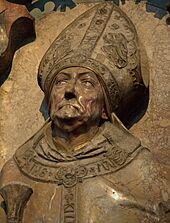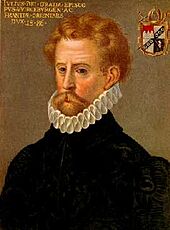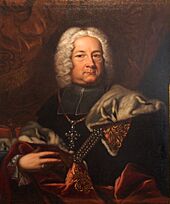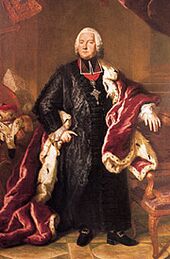Prince-Bishopric of Würzburg facts for kids
Quick facts for kids
Prince-Bishopric of Würzburg
Fürstbistum Würzburg (German)
|
|||||||||
|---|---|---|---|---|---|---|---|---|---|
| 1168–1803 | |||||||||
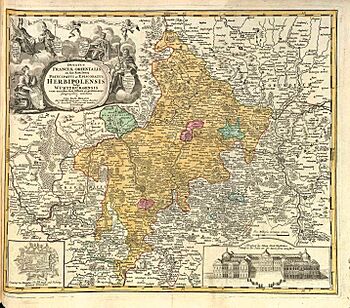
The Prince-Bishopric of Würzburg in the 18th century
|
|||||||||
| Status | State of the Holy Roman Empire | ||||||||
| Capital | Würzburg | ||||||||
| Common languages | East Franconian German | ||||||||
| Religion | Roman Catholic | ||||||||
| Government | Prince-Bishopric | ||||||||
| Prince-Bishop | |||||||||
|
• First bishop (743–755)
|
St Burchard I | ||||||||
|
• First Prince-Bishop (1165–1170)
|
Herold von Hochheim | ||||||||
|
• Last (1795–1808; Prince-Bishop to 1803)
|
Georg Karl von Fechenbach | ||||||||
| Historical era | Middle Ages | ||||||||
|
• Bishopric founded
|
743 | ||||||||
|
• Raised to prince-bishopric
|
1168 | ||||||||
|
• Prince-Bishops styled Dukes in Franconia
|
1441 | ||||||||
|
• Ecclesiastical Prince of Franconian Circle
|
1500 | ||||||||
| 25 February 1803 | |||||||||
|
• Ceded to Ferdinand and raised to Grand Duchy
|
30 September 1806 | ||||||||
|
|||||||||
The Prince-Bishopric of Würzburg was a special kind of state in the Holy Roman Empire. It was ruled by a bishop who was also a prince. This means the bishop had both religious power over a diocese (a church area) and political power over a territory. Würzburg is a city located in Lower Franconia, Germany.
The area around Würzburg had been a diocese since the year 743. Bishops in Germany were chosen by a group of church leaders called the cathedral chapter. Their choice then had to be approved by the Pope. It was common for these prince-bishops to rule more than one church territory. The last few prince-bishops lived in the Würzburg Residence. This is one of the most amazing Baroque palaces in all of Europe.
In 1803, the Prince-Bishopric of Würzburg, like other church-ruled states in Germany, lost its political power. This process was called secularization. The territory became part of Bavaria. Later, in 1805, a new state called the Grand Duchy of Würzburg was created. This new state did not last long. By 1814, it was once again taken over by Bavaria. The Roman Catholic Diocese of Würzburg was started again in 1821, but this time without any political power.
Contents
The Dukes of Franconia
In 1115, a powerful emperor named Henry V gave the land of Eastern Franconia to his nephew, Conrad of Hohenstaufen. Conrad used the title "Duke of Franconia." This area was a strong base for the Hohenstaufen family for many years.
In 1168, the Bishop of Würzburg officially gained the rights of a duke in Eastern Franconia. The name "Franconia" was not used much after that. However, the bishop brought the title back for himself in 1442. It was used until the changes made by Napoleon Bonaparte ended it.
Symbols and Coats of Arms
The original coat of arms for Würzburg showed a special banner called the "Rennfähnlein." It was a blue shield with a golden spear holding a banner that was white and red in quarters.
Later, in the 14th century, another coat of arms was created. This one was called the "Rechen," which means "rake." This symbol was meant to show the connection between heaven and earth. The three white points on the rake stood for the Holy Trinity. The four red points, pointing downwards, represented the four directions of the earth. The red color also symbolized the blood of Christ.
The prince-bishops often used both symbols in their own personal coats of arms. The "Rechen" and the "Rennfähnlein" represented the diocese. The other parts of the shield usually showed the bishop's own family coat of arms.
Important Leaders: The Prince-Bishops
The Prince-Bishopric of Würzburg was led by many different Prince-Bishops over the centuries. These leaders held both religious and political power. They played a big role in shaping the history of the region. Here are some of the notable Prince-Bishops who ruled Würzburg from 1168 to 1803:
- Herold von Hochheim 1165–1170
- Reginhard von Abenberg 1171–1186
- Gottfried I von Spitzenberg-Helfenstein 1186–1190
- Philip of Swabia 1190–1191
- Heinrich III of Berg 1191–1197
- Gottfried II von Hohenlohe 1197
- Konrad von Querfurt 1198–1202
- Heinrich IV von Katzburg 1202–1207
- Otto I. von Lobdeburg 1207–1223
- Dietrich von Homburg 1223–1225
- Hermann I von Lobdeburg 1225–1254
- Iring von Reinstein-Homburg 1254–1266
- Heinrich V von Leiningen 1254–1255
- Poppo III von Trimberg 1267–1271
- Berthold I von Henneberg 1271–1274
- Berthold II von Sternberg 1274–1287
- Mangold von Neuenburg 1287–1303 (Bishop of Bamberg 1285)
- Andreas von Gundelfingen 1303–1313
- Gottfried III von Hohenlohe 1313–1322
- Friedrich von Stolberg 1313–1317
- Wolfram Wolfskeel von Grumbach 1322–1332
- Hermann II Hummel von Lichtenberg 1333–1335
- Otto II von Wolfskeel 1335–1345
- Albrecht I von Hohenberg 1345–1349
- Albrecht II von Hohenlohe 1350–1372
- Gerhard von Schwarzburg 1372–1400
- Albrecht III von Katzburg 1372–1376
- Johann I von Egloffstein 1400–1411
- Johann II von Brunn 1411–1440
- Sigmund of Saxony 1440–1443
- Gottfried I von Limpurg 1443–1455
- Johann III von Grumbach 1455–1466
- Rudolf II von Scherenberg 1466–1495
- Lorenz von Bibra 1495–1519
- Konrad von Thüngen 1519–1540
- Conrad von Bibra 1540–1544
- Melchior Zobel von Giebelstadt 1544–1558
- Friedrich von Wirsberg 1558–1573
- Julius Echter von Mespelbrunn 1573–1617
- Johann Gottfried von Aschhausen 1617–1622 (Bishop of Bamberg 1609–1622)
- Philipp Adolf von Ehrenberg 1622–1631
- Franz von Hatzfeld 1631–1642 (Bishop of Bamberg 1633–1642)
- Johann Philipp von Schönborn 1642–1673
- Johann Hartmann von Rosenbach 1673–1675
- Peter Philipp von Dernbach 1675–1683
- Konrad Wilhelm von Wernau 1683–1684
- Johann Gottfried II von Gutenberg 1684–1698
- Johann Philipp von Greifenclau zu Vollraths 1699–1719
- Johann Philipp Franz von Schönborn 1719–1725
- Christoph Franz von Hutten 1724–1729
- Friedrich Karl von Schönborn 1729–1746 (also Bishop of Bamberg)
- Anselm Franz von Ingelheim 1746–1749
- Karl Philipp von Greifenclau zu Vollraths 1749–1754
- Adam Friedrich von Seinsheim 1755–1779 (Bishop of Bamberg 1757–1779)
- Franz Ludwig von Erthal 1779–1795 (also Bishop of Bamberg)
- Georg Karl Ignaz von Fechenbach zu Laudenbach 1795–1808
The political power of the Prince-Bishops ended in 1803. The territory then became part of Bavaria.
Places to See
- Würzburg Cathedral – This is where most of the Würzburg bishops were buried.
- Ebrach Abbey – Starting in the 1200s, many bishops had their hearts buried here. Their bodies were buried in Würzburg Cathedral. This was a special tradition. Prince-Bishop Julius Echter von Mespelbrunn chose to have his heart buried in a different church in Würzburg.
Gallery




